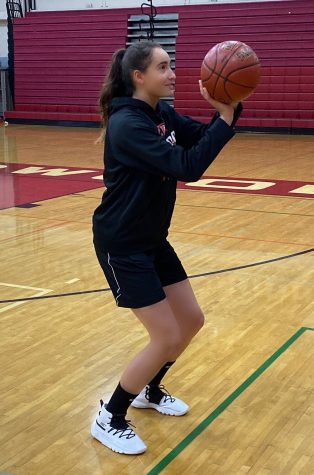Breaking the tall stereotypes at Redwood
December 9, 2019
While passing through the halls of Redwood and seeing the faces of people walking by, one head stands above the rest. One might stare in wonder and awe of the tall nature of the student. But besides their tall stature, how else is this student unique?
In the United States, the average high school boys’ and girls’ varsity basketball player is six feet three inches tall and five feet eight inches tall, respectively. If a male is taller than six feet, he has 10 times the chance of playing in the National Basketball Association than someone shorter than six feet. According to an Iowa State University study, people have an immediate assumption that tall people are athletes based on preconceived stereotypes. However, many people break these stereotypes in their everyday lives.

An aspiring musician, Kuisma enjoys playing his trombone out of school.
The Musician
Standing at six feet eight inches tall, sophomore Onni Kuisma feels pressured by society’s stereotypes regarding taller individuals.
“People always tell me that I am wasting an opportunity by not playing baseball or basketball, which puts a lot of pressure on me. It gives me the feeling that I am doing something wrong,” Kuisma said.
However, Kuisma would rather stay true to his interests and pursue music. Starting at nine years old, Kuisma began playing the trombone. Over the years he has become extremely invested in the instrument and likes to play it at home with his little sister.
“I love playing the trombone and find true happiness in it, so I just wish people would stop believing these stereotypes and accept my passion for music,” Kuisma said. “When I play the trombone, I am super relaxed and at peace. I love challenging myself to see what is the most complicated song I can play because the most satisfying feeling is reaching a new level.”
The Gamer

Halliday feels most at ease when he is immersed in the world of video games.
Similarly, six foot five inches tall junior Evan Halliday loves to stray away from the common stereotypes and create his own path. In lieu of competitive sports where height is an advantage, every weekend and on open weekdays, Halliday enjoys playing video games, such as Rocket League, on his computer. Ever since he was nine, when he received his first gaming console, he has been an avid video game player.
“By playing video games, I am able to make my own path. I can escape reality and bond with my friends. It is a great way to reduce my academic stress and a way for me to just have fun,” Halliday said.
According to Halliday, he soon wants to take video games to the next level. In the near future, Halliday hopes to compete in tournaments against other players and hopefully make money from playing.
“Being able to spend time on [academics] and video games is very beneficial because I can really focus on the things I truly enjoy, which I wouldn’t be able to do if I played a sport,” Halliday said.

Putting in hard work, Leonard practices her free throw skills
The Athlete
On the contrary, sophomore Sadie Leonard, who is six feet one inch tall, loves to play sports and uses her height to her advantage. Competitive sports excited Leonard ever since she was six. Currently, she is on the girls’ varsity basketball team, and last year she was on the varsity softball team as a freshman. She hopes to continue her softball career and eventually play in college.
“[My height] has given me the ability to play at such a high competitive level… Also, height is very beneficial for the [college] recruiting process, as you walk onto the court or the field the scouts will automatically keep an eye on you purely for your height,” Leonard said.
Moreover, Leonard feels there are several preconceived notions about tall people she does not want to follow. Adults commonly expect her to be more mature than her age due to her height; however, she would rather be herself and act her age.
“It is just hard because people always assume I am older than I actually am. Adults always expect me to be more mature because I am tall,” Leonard said. “It’s extremely annoying because I feel I let people down if I act my true age and have fun, and it is just embarrassing to be a kid a lot of the time.”
Whether students like Leonard are using their height to benefit them in their athletic endeavors, or Halliday and Kuisma who choose to spend their time doing something not related to sports, it is apparent that these students do not want their height to define them and what they do. Instead, their heights are merely a component of who they are as individuals.







